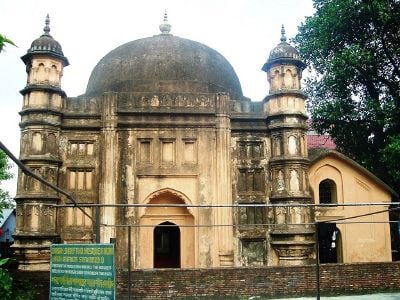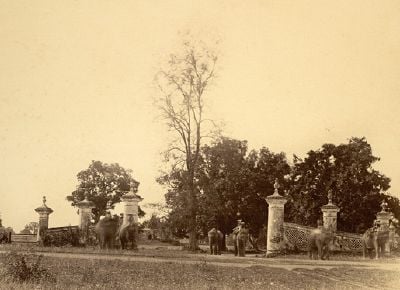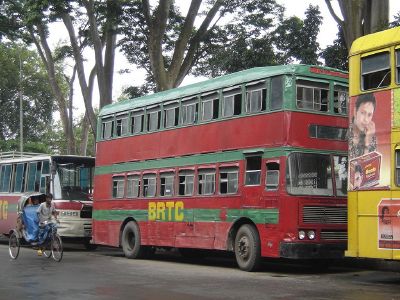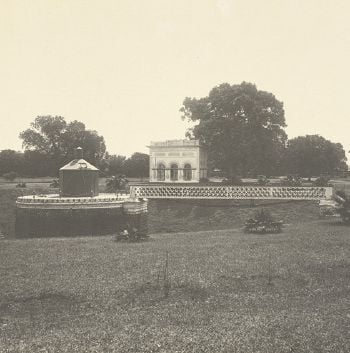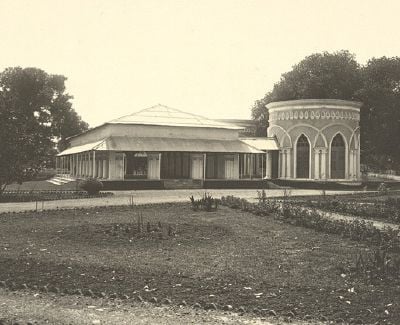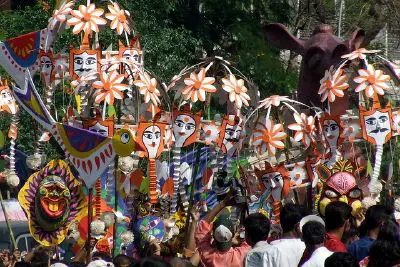Shahbag
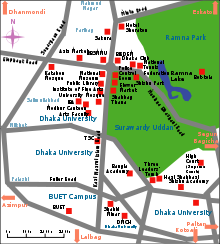 Map of the neighbourhood | |
| Administration | |
|---|---|
| Wards | 51, 52, 53 |
| Parliamentary Seat | Dhaka-10 (Ramna-Tejgaon) |
| Municipality | Dhaka |
| Coordinates | 23°44'18" N, 90°23'45" E |
| RAB Area | RAB 3 |
| Information | |
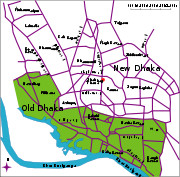 Location of Shahbag in Dhaka | |
| Established | 2004* |
| Area | 17.4 km²* |
| Population | 112,000* |
| HQ | Shahbag Intersection |
| Neighbouring Thanas | Lalbag, Dhanmondi, Ramna, Kotwali, Paltan, New Market |
| Website | DMP page on Shahbag |
| * Dhaka Metropolitan Police data | |
Shahbag (also Shahbaugh, Bengali: শাহবাঠShabag; IPA: [ËÊabag]) is a major neighborhood in Dhaka, the capital of Bangladesh. A major public transport hub, Shabag serves as a junction between two contrasting sections of the city, Old Dhaka and New Dhaka, which lie respectively to the north and south. Old Dhaka served as the provincial capital and a center of the flourishing muslin industry. Shahbag developed in the seventeenth century during Mughal rule in Bengal. The neighborhood was originally named Bagh-e-Badshahi (Persian: Garden of the Master Kings). Later the name shortened to Shah (Persian:شاÙ, king) Bagh (Persian: باغ, garden). In the mid-nineteenth century, new building construction in and around Shahbag ushered in the development of New Dhaka as a provincial center of the British Raj and ended a century of decline.
The nation's leading educational and public institutions, the University of Dhaka, the oldest and largest public university in Bangladesh, and the Bangladesh University of Engineering and Technology, the country's largest public university for technological studies have made Shahbag their home. Shahbag also hosts many street markets and bazaars, following the emergence of Bangladesh as an independent country. The Shahbag area has become a popular venue for celebrating festivals, such as the Bengali New Year and Basanta Utsab.
Shahbag's numerous ponds, gardens, and palaces have inspired the work of multitude writers, singers, and poets. The Thana area, centering around Dhaka University, has seen the debut of major political movements in the nation's history. The All India Muslim Education Conference in 1905, which gave rise to the All India Muslim League and led, in 1947, to the partition of India and the creation of Pakistan began there. The Bengali Language Movement started there in 1952 and led to the recognition of Bengali as an official language of Pakistan. The Six point movement of 1966 led to the nation's independence. It was at Thana on March 7, 1971, that Sheikh Mujibur Rahman delivered a historic speech calling for the independence of Bangladesh from Pakistan. Thana has since become a central staging ground for protests by students and other groups.
History
Although urban settlements in the Dhaka area date back to the seventh century C.E., monuments constructed after 1610, when the Mughals turned Dhaka into a provincial capital and established the gardens of Shahbag, provide the earliest evidence of urban construction in the Shahbag area. Among those monuments are: the Dhaka Gate, located near the Bangla Academy in Shahbag, and erected by Mir Jumla, the Mughal subadar of Bengal from 1660 to 1663; the Mariam Saleha Mosque, a three-domed Mughal-style mosque in Nilkhet-Babupara, constructed in 1706;[1] the Musa Khan Mosque on the western side of Dhaka University, likely constructed in the late seventeenth century;[2] and the Khwaja Shahbaz's Mosque-Tomb,[3] located behind the Dhaka High Court and built in 1679 by Khwaja Shahbaz, a merchant-prince of Dhaka during the vice-royalty of Prince Muhammad Azam, the son of Mughal Emperor Aurangzeb.[4]
With the decline of Mughal power in Bengal, the Shahbag gardensâthe Gardens of the Kingsâfell into neglect. In 1704, when the provincial capital moved to Murshidabad, they became the property of the Naib Nazimsâthe Deputy-Governors of the sub-province of East Bengalâand the representatives of the Nawabs of Murshidabad. Although the British established power in Dacca in 1757, the upkeep of Shahbag gardens resumed only in the early nineteenth century under the patronage of an East India Company judge, Griffith Cook,[5] and a leader of the Armenian community of Dhaka, P. Aratun. In 1830, the Ramna area, which included Shahbag, incorporated into Dhaka city consequent to the deliberations of the Dacca Committee (for the development of Dacca town) founded by district collector Henry Walters.[6] A decade later, Nawab Khwaja Alimullah, founder of the Dhaka Nawab Family and father of Nawab Khwaja Abdul Ghani, purchased the Shahbag zamindari (estate) from the East India Company. Upon his death, in 1868, the estate passed to his grandson Nawab Khwaja Ahsanullah. In the early twentieth century, Ahsanullah's son, Sir Nawab Khwaja Salimullah, reclaimed some of the lost splendor of the gardens by dividing them into two smaller gardensâthe present-day Shahbag and Paribag (or, "garden of fairies")âthe latter named after Paribanu, one of Ahsanullah's daughters.[7]
With the partition of Bengal in 1905, and with Dacca becoming the capital of the new province of East Bengal, European-style houses were rapidly built in the area, especially along the newly-constructed Fuller Road (named after Sir Bampfylde Fuller, the first Lieutenant Governor of East Bengal). Around that time, the first zoo in the Dhaka area opened in Shahbag.[8]
After the creation of the new nation of Pakistan in 1947, when Dhaka became the capital of East Pakistan, many new buildings were built in the Shahbag area, including, in 1960, the office of Bangladesh Betar, (then Pakistan Radio), the national radio station, the (now-defunct) Dacca race-course, as well as the second electric power-plant in East Bengal. On March 7, 1971, Sheikh Mujibur Rahman chose the Ramna Racecourse near Shahbag to deliver his speech calling for an independent Bangladesh. During the ensuing Bangladesh Liberation War, many foreign journalists, including the Associated Press bureau chief in Pakistan, Arnold Zeitlin, and Washington Post reporter, David Greenway stayed at Hotel Intercontinental (now Hotel Sheraton) at the Shahbag Intersection. The hotel, which had been declared a neutral zone, nonetheless came under fire from both combatants in the warâthe Mukti Bahini and Pakistani army. At the conclusion of the war, the Hotel Intercontinental was at first chosen as the venue for the surrender ceremony of the West Pakistan army; the final surrender ceremony later took place in the nearby Ramna Park (now Suhrawardy Uddan).
Urban layout
- See also: Dhaka
With an area of 4.2 square kilometers (1.6 sq mi) and an estimated 2006 population of 112,000. Shabag lies within the monsoon climate zone at an elevation of 1.5 to 13 meters (5 to 43 ft) above mean sea level. Like rest of Dhaka city it has an annual average temperature of 25 °C (77 °F) and monthly means varying between 18 °C (64 °F) in January and 29 °C (84 °F) in August. Nearly 80 percent of the annual average rainfall of 1,854 mm (73 in) occurs between May and September. The Shahbag neighborhood covers a large approximately rectangular area, extending on the east from Ramna Park to the Supreme Court of Bangladesh; on the west as far as Sonargaon Road; on the south as far as Fuller Road and from the University of Dhaka to the Suhrawardy Udyan (formerly, Ramna Racecourse); and on the north as far as Minto Road, Hotel Sheraton and the Diabetic Hospital.
Shahbag serves as home to the Dhaka Metropolitan Police (DMP) Control Room as well as a Dhaka Electric Supply Authority substation. The mausoleums of three leadersâBengali statesman A.K. Fazlul Huq (1873â1962), former Prime Minister of Pakistan, Huseyn Shaheed Suhrawardy (1892â1963), and former Prime Minister and Governor-General of Pakistan, Khwaja Nazimuddin (1894â1964)âare all located in Shahbag. The major academic bodies around Shahbag Intersection and in Shahbag Thana area include: Dhaka University, Dhaka Medical College, BUET, Bangladesh Civil Service Administration Academy, Bangabandhu Sheikh Mujib Medical University (BSMMU, the only public medical university in the country, Institute of Fine Arts (formerly, Dhaka Art College), Institute of Cost & Management Accountants, IBA, Institute of Modern Languages, Udayan School, University Laboratory School, and the Engineering University School. Other public and educational institutions in the area include the Bangladesh National Museum, the Central Public Library, and the Shishu Academy, the National Academy for Children.
The Shahbag Intersection, the nerve center of the neighborhood, is the location of many Dhaka landmarks. Well-known ones include Hotel Sheraton[9] (formerly Hotel Intercontinental, the second five-star hotel in Dhaka); the Dhaka Club, the oldest and largest club in Dhaka, established in 1911; the National Tennis Complex; Shishu Park, the oldest children's entertainment park in Dhaka, notable for admitting underprivileged children gratis on weekends; Sakura, the first bar in Dhaka; and Peacock, the first Dhaka bar with outdoor seating. The Shahbag Intersection constitutes one of the major public transportation hubs in Dhaka, along with Farmgate, Gulistan, Mohakhali, and Moghbazar.
The thana also contains a hospitals complex, a major destination for Bangladeshis seeking medical treatment. The Diabetic Association of Bangladesh (DAB), BIRDEM (Bangladesh Institute of Research and Rehabilitation in Diabetes, Endocrine and Metabolic Disorders) and the BIRDEM Hospital are located at the Shahbag Intersection. Flanking BIRDEM hospital is the Ibrahim Memorial Cardiac Hospital, named after Dr Muhammad Ibrahim, the founder of DAB and BIRDEM. Other facilities in the area include BSMMU Hospital (at the Intersection) and the Dhaka Medical College Hospital at the southern end of Shahbag.
Located at the juncture of two major bus routes â Gulistan to Mirpur and Motijheel to Uttara â Shahbag Intersection serves as a public transport hubs in Dhaka, where the population commutes exclusively by the city bus services. The Intersection also has one of the few taxi stands in Dhaka. The thoroughfares of Shahbag has been made free of cycle-rickshaws, the traditional transport of Dhaka.
Historic mansions
Also located in Shahbag are several mansions built by Dhaka Nawab Family in the nineteenth century. Those mansions not only figured prominently in the history of Dhaka, but also gained mention in the histories of both Bengal and British India.
A well-known Nawab family mansion is the Ishrat Manzil. Originally, a dance-hall for the performances of Baijees, or dancing women, (including, among the famous ones, Piyari Bai, Heera Bai, Wamu Bai and Abedi Bai), the mansion became the venue for the All-India Muslim Education Society Conference in 1906, attended by 4000 participants. In 1912, Society convened there again under the leadership of Nawab Salimullah, and met with Lord Hardinge, the Viceroy of India. The Ishrat Manzil, subsequently rebuilt as Hotel Shahbag (designed by British architects Edward Hicks and Ronald McConnel), became the first major international hotel in Dhaka. In 1965, the Institute of Post-graduate Medicine and Research (IPGMR) acquired the building. Later, in 1998, the Bangabandhu Sheikh Mujib Medical University (BSMMU) moved in.[10]
Another Nawab mansion is the Jalsaghar. Built as a skating rink and a ballroom for the Nawabs, it was later converted into an eatery and meeting place for students and faculty of Dhaka University and renamed Modhur Canteen. In the late 1960s, Modhur Canteen became a focal point for planning student protests against the West Pakistan regime. Flanked on one side by the Arts Faculty of Dhaka University and on the other by the IBA (Institute of Business Administration), the Modhur Canteen remains a powerful political symbol.
Nishat Manjil, built as the princely stable and clubhouse for the Nawabs, served as a venue of receptions for the statesmen of the day, including Lord Dufferin (Viceroy of India), Lord Carmichael (Governor of Bengal), Sir Steuart Bayley (Lt. Governor of Bengal), Sir Charles Elliott (Lt. Governor of Bengal), and John Woodburn (Lt. Governor of Bengal).
Khwaja Salimullah built the Nawab's Paribag House in the memory of his sister, Pari Banu. Later, with the downturn in the family's fortunes, his son, Nawab Khwaja Habibullah, lived here for many years. The hammam (bath) and the hawakhana (green house) were regarded as marvels of design in early twentieth century.[7]
Sujatpur Palace, the oldest Nawab mansion in the area, later became the residence for the Governor of East Bengal during the Pakistani Regime, and subsequently the Bangla Academy, the Supreme Bengali Language Authority in Bangladesh. The TSC (Teacher Student Center) of Dhaka University took over some of the palace grounds, becoming a major cultural and political meeting place in 1970s.
Culture

Teachers and students make up most the population of Shahbag, and the activities of its academic institutions dominated its civic life. Its commercial life, too, reflects its occupants' intellectual and cultural pursuits. Among its best known markets is the country's largest second-hand, rare, and antiquarian book-market, comprising Nilkhet-Babupura Hawkers Market, a street market, and Aziz Supermarket, an indoor bazaar. Shahbag is also home to the largest flower market (a street side open air bazaar) in the country, located at Shahbag Intersection, as well as the largest pet market in the country, the Katabon Market. In addition, Elephant Road features a large shoe market and, Nilkhet-Babupura, a large market for bedding accessories.
Shahbag's numerous ponds, palaces and gardens have inspired the work of artists, including poet Buddhadeva Bose, singer Protiva Bose, writer-chronicler Hakim Habibur Rahman, and two Urdu poets of nineteenth century Dhaka, Obaidullah Suhrawardy and Abdul Gafoor Nassakh.[11] Shahbag stood at the center of the cultural and political activities associated with the Language movement of 1952, resulting in the founding of the Bangla Academy, a national academy for promoting the Bengali language. Zainul Abedin founded the first formal art school in Dhakaâthe Dhaka Art College (now Institute of Fine Arts)âin Shahbag in 1948. Later, Mazharul Islam, the pioneer of modern architecture in Bangladesh, designed the Art College as one of his early projects. In the 1970s, Jiraz Art Gallery opened as the first commercial art wing in the Shahbag area. Other cultural landmarks in the area include the Bangladesh National Museum,[12] the National Public Library, and the Dhaka University Mosque and Cemetery, containing the graves of Kazi Nazrul Islam, the national poet, of painters Zainul Abedin and Quamrul Hassan, and of the teachers killed by Pakistani forces during the Bangladesh Liberation War of 1971.
The Shahbag area has a rich religious history. In the late 1920s, Sri Anandamoyi Ma, the noted Hindu ascetic, also known as the Mother of Shahbag, built her ashram near Ramna Kali Mandir, or the Temple of Kali, at Ramna. Her presence in Dhaka owed directly to Shahbag, for her husband, Ramani Mohan Chakrabarti, had accepted the position of caretaker of Shahbag gardens a few years earlier. In 1971, the Pakistani Army destroyed the "Temple of Kali" in the Liberation War of Bangladesh.[13] A well-known local Muslim saint of the early twentieth century was Syed Abdur Rahim, supervisor of the dairy farm established by Khwaja Salimullah, the Nawab of Dhaka, at Paribag. Known as the Shah Shahib of Paribag, Abdur Rahim had his khanqah (Persian: خاÙگاÙ, spiritual retreat) here; his tomb lies at the same location today.[14] Katabon Mosque, an important center for Muslim missionaries in Bangladesh, is located in Shahbag as well. In addition, the only Sikh Gurdwara in Dhaka stands next to the Institute of Modern Languages in Shahbag.
Since 1875, the Shahbag gardens have hosted a famous fair celebrating the Gregorian New Year and containing exhibits of agricultural and industrial items, as well as those of animals and birds. In the late nineteenth century and early twentieth century, the gardens were the private property of the Nawab of Dhaka, and, although a portion of the gardens had been donated to Dhaka University in 1918, ordinary citizens could enter the main gardens only during the fair. In 1921, at the request of the Nawab's daughter, Paribanu, the organizers of the fair set aside one day during which only women were admitted to the fair, a tradition that has continued down to the present. Today, the fair features dance recitals by girls, Jatra (a native form of folk theater), putul naach (puppet shows), magic shows and Bioscope shows.[10] Historically, Shahbag served also the main venue in Dhaka for other recreational sports like Boli Khela (wrestling) and horse racing.
The Basanta Utsav (Festival of Spring) takes place every February 14âthe first day of spring, according to the reformed Bangladeshi Calendar.[15] Originating in Shahbag in the late 1960s, Basanta Utsav has now become a major festival in Dhaka. Face painting, wearing yellow clothes (signifying Spring), music, and local fairs are typical of the many activities associated with the festival, which often also includes themes associated with Valentine's Day. Shahbag is also the focal point of the Pohela Baishakh (the Bengali New Year) festival in Dhaka, celebrated every April 14 following the revised Bengali Calendar, and now the biggest carnival in Dhaka.[16] From 1965 to 1971 the citizens of Dhaka observed the festival as a day of protest against the Pakistani regime. Other local traditions associated with the festival include the Boishakhi Rally and the Boishakhi Mela begun by the Institute of Fine Arts and the Bangla Academy respectively. In addition, Chayanaut Music School began the tradition of singing at dawn under the Ramna Batamul (Ramna Banyan tree).
Books and movies figure prominently in the cultural life of Shahbag. The biggest book fair in Bangladesh is held every February on the premises of the Bangla Academy in Shahbag. The only internationally recognized film festival in Bangladeshâthe Short and Independent Film Festival, Bangladeshâtakes place every year at the National Public Library premises. The organizers of the film festival, the Bangladesh Short Film Forum, have their offices in Aziz Market.
Notes
- â Mariam Saleha Mosque Banglapedia. Retrieved January 5, 2024.
- â Musa Khan Mosque Banglapedia. Retrieved January 5, 2024.
- â Khwaja Shahbazâs Mosque and Tomb Banglapedia. Retrieved January 5, 2024.
- â Sayid Aulad Hasan, Notes on the Antiquities of Dacca (Dacca: University Press Limited, 1904).
- â Sharif Uddin Ahmed, Dacca (London: Riverdale Co Pub., 1986, ISBN 0913215147), 131
- â Dhaka under the East India Company (1764-1858). Dhaka City Corporation. Retrieved January 5, 2024.
- â 7.0 7.1 Paribag Banglapedia. Retrieved January 5, 2024.
- â Ramna Racecourse Banglapedia. Retrieved January 5, 2024
- â Sheraton Dhaka Marriott International, Inc.. Retrieved January 5, 2024.
- â 10.0 10.1 Shahbag Banglapedia. Retrieved January 5, 2024.
- â Syed Muhammed Taifoor, Glimpses of Old Dhaka (Dacca: SM Perwez, 1952), 257-258.
- â Bangladesh National Museum. Retrieved January 5, 2024.
- â SD Khan, The Race Course Maidan that once was The Daily Star, Bangladesh (November 11, 2005). Retrieved January 5, 2024.
- â Amulyakumar Duttagupta, Shree Shree Ma Anandamayi Prosonge (vol 1). (Dhaka: 1938), 2â3 (in Bengali).
- â Basanta Utsav Ministry of Tourism. Retrieved January 5, 2024.
- â Pahela Baishakh Bangladesh Tourism Board. Retrieved January 5, 2024.
ReferencesISBN links support NWE through referral fees
- Ahmed, Sharif Uddin. Dacca: A Study in Urban History and Development. London: Riverdale Co Pub., 1986. ISBN 0913215147
- Ahmed, Sharif Uddin. Dhaka: Itihasa o Nagarjiban: 1840â1921. á¸hÄkÄ: EkÄá¸emika Presa eá¹á¸a PÄbaliÅÄrsa, 2001. ISBN 9789840801626
- Hasan, Sayid Aulad. Notes on the Antiquities of Dacca. Dacca: University Press Limited, 1904. ASIN B0000CQXW3
- Islam, Nazrul. ''Dhaka: From city to megacity : perspectives on people, places, planning, and development issues. Urban Studies Programme, Department of Geography, University of Dhaka, 1996. ISBN 984510004X
- Mamoon, Muntasir. Dhaka: Smrti Bismrtir Nagari. Dhaka: Ananya Publishers, 2004. ISBN 9844121043
- Rabbani, Golam. Dhaka: from Mughal Outpost to Metropolis. Dhaka: University Press Limited, 1997 .ISBN 9840513745
- Taifoor, Syed Muhammed. Glimpses of Old Dhaka. Dacca: SM Perwez, 1952.
Credits
New World Encyclopedia writers and editors rewrote and completed the Wikipedia article in accordance with New World Encyclopedia standards. This article abides by terms of the Creative Commons CC-by-sa 3.0 License (CC-by-sa), which may be used and disseminated with proper attribution. Credit is due under the terms of this license that can reference both the New World Encyclopedia contributors and the selfless volunteer contributors of the Wikimedia Foundation. To cite this article click here for a list of acceptable citing formats.The history of earlier contributions by wikipedians is accessible to researchers here:
The history of this article since it was imported to New World Encyclopedia:
Note: Some restrictions may apply to use of individual images which are separately licensed.
